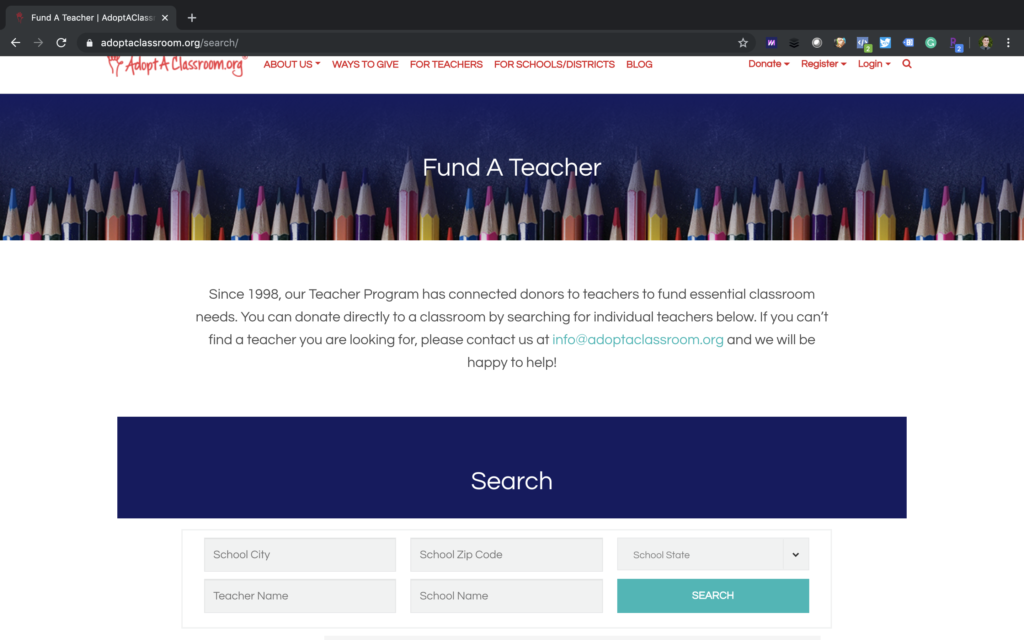As a growing number of school communities turn to crowdfunding and raise more money than ever before for their classrooms and programs, what should be celebrated as a victory has turned into a concern for school district administrators.
The concept of online fundraising in K-12 schools has erupted over the last decade as a combination of the perfect storm: community members got tired of having to buy things and just want to make a donation, online fundraising made giving easy, and made it possible to share fundraisers quicker than ever before. Since it’s become one of the most effective ways to raise funds for just about anything, it’s not slowing down any time soon.
What was unfortunately discovered as a result of its growth were the unintended potential consequences. Many school districts are learning about these consequences through the numerous articles, reports, and guidance published about crowdfunding, and are now faced with the new challenge of supporting online fundraising in their schools in a way that safeguards everyone involved. Doing this requires a district-wide systematic approach, which has now sent school districts looking for a solution.
Luckily, some school districts around the country are getting ahead and leading the way. Instead of banning crowdfunding, these districts have embraced it and supported their members’ ambitions by putting new policies, procedures, and platforms in place that provide additional coordination between the fundraiser creators and the school and district administrators.
This guide was written based on the steps these school districts took to successfully put items in place that solve these issues and support fundraising in their districts.
1. Understand What Crowdfunding Is
In its most basic sense, the process of crowdfunding in K-12 education starts when someone from a classroom, a team, a school program, a parent organization, or other school-associated group has an idea that requires funding, for which they create an online-based fundraiser. In order to gain donations, the creator usually has to do some level of promotion by sharing with family, friends, community members, and others across the web. Once funded, the donation is sent to the creator by means of funds or items. EdSurge uses a great visual to describe this process in their Crowdfunding Research Report.
There are a wide variety of crowdfunding sites on the web. General crowdfunding sites like GoFundMe and Fundly are made for anyone to raise money for almost any cause. There are some sites like Kickstarter or Indiegogo that are for more specific causes, like funding creative projects and innovative ideas by entrepreneurs. And finally, there are sites that are specific to education, so specific even, that they are made only for specific user groups – for example, sites like AdoptAClassroom and DonorsChoose are made only for teachers, and sites like SnapRaise are made for teams and programs. The challenge this creates for school districts is finding just one education-specific platform to use that fits the needs of their teachers, teams, clubs, and programs.
For more insight on crowdfunding and things that districts should know, an article by Fisher Phillips Law Firm also does a solid job explaining how the process works.
2. Be Aware of What’s At Stake
Certain legal, financial, and reputational issues can pose potential risks for those involved with online fundraisers, sparking districts to establish protective policies and procedures. Having a thorough understanding of these issues is what has helped many school districts reach the best solution.
The process of crowdfunding in K-12 school districts has been described as “decentralized” due to the lack of controls and coordination available to school districts, which in turn can also create a number of potential legal, financial and reputational risks for the district, the organizer, and the donor. For a better understanding of how the issues of K-12 crowdfunding have evolved, quickly watch Livingtree CEO Gary Hensley discuss today’s current crowdfunding situation, and some of the issues it’s creating for school districts.
The liabilities created by these campaigns can be rather serious as warned about by a number of school boards, attorneys, and state auditors, which can result in PR nightmares, a loss of funds or inventory, or worst-case legal action against a school or district. For a list of the potential liabilities that school districts should know about, read our blog “The Liabilities of Crowdfunding for K-12 School Districts.”
3. Understand What Is Happening In Your District
Understanding what’s happening in your school district is the first step in addressing these issues, which will help you navigate the upcoming steps and avoid push back by members of your district when it comes time to decide on policies and procedures. While the risks are serious, some school districts have come under fire from teachers and the public after quickly banning crowdfunding sites without creating any available alternatives, as written about in Education Week.
To understand what crowdfunding platforms are being used in your district, a census, or even a survey of a few schools can be most telling. This can help you determine what groups are using what platforms, the frequency they are being used, and how much money or inventory they are collecting as a result.
Another option is to simply do some research to see what’s out there. How? You can usually find the currently active crowdfunding campaigns, and often times even the completed ones, just by searching these sites by the name of your school district, schools or location.

While this requires you to do some digging through crowdfunding sites that your district members might be using (since you won’t know every site being used), the option is typically easier and may give you the answers you need. We suggest starting with some of the more popular sites, such as DonorsChoose, GoFundMe, AdoptAClassroom, and PledgeCents. For more on taking this step to understand what’s happening in your district, here is Lana Berry, Chief Financial Officer of Chandler Unified:
4. Understand the Guidance
Because of the potential liabilities and risks from Step Two, guidance around crowdfunding has been issued by a number of organizations across the country, including state and local school boards, education law firms and attorneys, state auditors and comptrollers, and even media outlets. The guidance urges districts to implement policies and procedures around crowdfunding, and contains items and content that should be considered.
“Because of these risks, it is prudent for school districts to adopt a crowdfunding policy that mitigates them.”
– Published by Dave Yost, Ohio Auditor of State in his Special Crowdfunding Report (2018)
With a host of resources already available, it’s important to understand the guidance and how you can incorporate it into your district’s decisions. As discovered in our research, several consistencies exist across the guidance that has been issued.
This article examines the guidance suggested by:
1. Erin Duryea Gilsbach, Esq. at the King, Spry, Herman, Freund & Faul in the article written for the National School Board Association’s Council of School Attorneys.
2. Dave Yost, the Ohio Auditor of State in his Special Report on crowdfunding.
3. The California School Boards Association’s guidance article on crowdfunding.
4. The Fisher Phillips Law firm in their article on “What School Districts Need To Know About Crowdfunding“
Here is the guidance listed most consistently across their publications that should be understood and carefully considered:
School Districts Should Require Prior Administrative Approval of Fundraising Campaigns
As suggested across all publications, one of the most agreed-upon requirements is that school districts should have a pre-approval process for administrators to review and approve the fundraising campaigns before they are published on permissable sites. The reviewing administrators at the school and/or district level should carefully review the campaigns for potential issues and violations, and ensure the campaigns are compliant with all board policies.
In some cases, the guidance suggests that the Superintendent should review or designate another district employee to review the campaigns, and districts should mandate that no donations be accepted without school board approval.
One consideration that should be taken into account is that approval processes can become messy, requiring forms from across the district to be submitted, properly routed, and recorded, which can potentially inundate business offices.
However, many districts like Chandler Unified have gotten ahead of these issues. These districts have implemented a solution that streamlines this process through a central system and ensures that campaigns are always reviewed by the correct administrators, tracked with audit trails, and reported on when the campaign is fully funded.
School Districts Should Identify An Approved Crowdfunding Site List
School districts should develop a list that identifies the crowdfunding platforms and sites that may be used by district members. This list should be created based on a number of considerations, the first being the safeguards, controls, and level of coordination available to district administration – this may include whether the platform has a built-in approval system, how campaigns are tracked, the audit trails available, and the reporting provided to the district. Other considerations include who the platform’s intended use is for (is it only for a specific group like teachers, or can it be used by anyone?), fees or percentages charged by the site, and the effectiveness/usability of the fundraising platform.
Other considerations include who the platform’s intended use is for (is it only for a specific group like teachers, or can it be used by anyone?), fees or percentages charged by the site, and the effectiveness/usability of the fundraising platform.
School Districts Should Require That Donations Are Distributed Through the District or School
When a fundraising campaign is completely funded, as stated in the CSBA’s guidance, “districts should ensure that donations are subject to fiscal accountability measures related to the collection, accounting, expenditure, inventory and audit of donations.” The guidance across these resources states that school districts should require that the donations be routed through the district and/or school accounts, and then distributed to the organizer.
In the case of monetary donations, ensuring the donation goes to a district or school account provides safeguards and can provide tax relief to the donor. This process provides administration with the ability to properly record and track the donation, and equip any physical donations with inventory tags and/or the required software.
School Districts Should Establish That All Donations Are Property of the District
This requirement should be established and made clear through policy and/or procedures. The policy should specify that donations are the property of the district, and that the proceeds or donations from any proposal remain with the school. This ensures that donations remain in place for their original intended purposes in the event that the original campaign creator terminates his or her employment.
5. Use Your Resources to Make Decisions
Making district-wide decisions about crowdfunding isn’t easy and can look different in every district. You are going to have to make changes to your procedures, guidelines, and even your policies, which typically requires collaboration between the Superintendent, district cabinet members, the finance office, and the school board.
If someone has made it to this step of the process, it’s important to make sure that everyone is on the same page and understands everything we’ve covered in previous steps. If you are looking for presentations that cover this topic, you can take a look at “Crowdfunding – Setting Your District Up for Success!” by Chandler Unified School District’s Chief Financial Officer Lana Berry or “Legal Issues and School Board Policies on Crowd Source Funding” by the North Carolina School Boards Association’s Staff Attorney, Justice Warren.
Because laws and regulations in regard to raising funds can differ state by state, your team may also want to consult other agencies such as your state school boards association and your state auditor or comptroller, before making any further decisions. Before enacting any procedures in their district, Chandler USD made sure to consult their state school boards association and state auditor to ensure they understood the regulations and how to maintain compliance.
Using school districts that have already enacted controls to support online fundraising activities can also be a great resource. There are a growing number of school districts across the country, Chandler USD included, that have led the way and made strides to tackle these issues. You can view the crowdfunding procedures from Chandler USD, and the policy from Union County School District, both of which are notable districts in terms of successfully supporting online fundraising through policy and platform.
Bonus info: Get the School District Crowdfunding Considerations Guide for a real example of the risks that school districts are facing and the 7 areas that administrators need to consider.
6. New Policy, Procedures & Guidelines, and Platforms
Once you’ve done your homework, and fully understand what your district should do to protect your fundraising organizers, it’s time to solidify your plans through guidelines, procedures, and policies that provide expectations for district members.
One of the most surprising discoveries made by Chandler USD as they initially went through this process was the fact that they had to make very few changes to their board policy. In talking with their Chief Financial Officer Lana Berry, she stated that many districts already have board policy that covers fundraising, which is usually all that’s needed. The major changes they made were in their procedures and guidelines.
Some districts do choose to re-write this section of their policy, or add in a section on crowdfunding such was done at Union County School District. If your district is advised to make this change, you can use the examples we’ve already listed, as well as the rules that were adopted by New Prague Area Schools, Minnesota, outlined in our previous blog. The three resources listed in Step Four contain valuable policy and procedural recommendations that you reference when making these changes.
7. Roll Out Your Changes
Once you’ve solidified your new policies, procedures, and/or platforms, you’ll need to roll out these changes across your district, making sure everyone in your district knows about the updated crowdfunding procedures. Livingtree typically provides its partner districts with communication tool-kits that assist with this communication, but it’s a good start to consider a press release, announcements via social media, email, or newsletter, and even letters to your staff.
Another option to aid is awareness is providing professional development around your new fundraising path. If you’ve identified a list/an approved crowdfunding site for your district to use, identify a champion in the district or at every school who understands how to use them, and help everyone follow the new procedures. This would provide a great opportunity for fundraisers to get approved on the spot, and then launched online. Many school districts that have already gotten ahead of these issues have found success by providing professional development and training on their selected platforms that establishes best practices to maximize the funds they raise.
Of course, fundraising isn’t always at the top of everyone’s minds all the time, so it’s very likely that someone doesn’t remember the new required procedures and launches a campaign without approval or on a site that isn’t approved. That’s ok – it’s an adjustment.
Some monitoring of social media and crowdfunding websites may be required from time to time to ensure the rules are being followed. If you find they aren’t, a gentle reminder is all it takes. Remember, this is about protecting your schools, fundraiser creators, and donors so they don’t ever find themselves in hot water because they tried to do something good for their students.

In conclusion, to make crowdfunding work in your district:
1. Understand that crowdfunding in K-12 schools is the process of someone launching a fundraiser online, sharing it with the community and others across the web, and raising money for a school idea.
2. Be aware that crowdfunding in school districts without processes or oversight can lead to potential legal, financial and reputational risks for the district, the organizer, and the donor.
3. Understand what’s happening specifically in your district by either conducting a census or survey of your district members, or doing research on popular crowdfunding sites.
4. Understand that all of the guidance published for school districts suggests implementing policies and procedures around crowdfunding, and contains resources that you can incorporate it into your district’s decisions.
5. Use or reference existing resources like the crowdfunding presentations, your state school boards association, your state auditor or comptroller, and school districts that have led the way and have already tackled these issues.
6. Write your new policy, procedures, and guidelines, and use your resources to do so.
7. Roll out your changes, making sure to communicate and create awareness about the updated procedures.
Livingtree is not only helping school districts across the country implement a central platform to pre-approve, track, and report every fundraiser, but is also assisting school districts through the early steps. If you need help with any of the steps above, Livingtree can help! Simply email info@livingtree.com, and our team can help provide reports and guidance around crowdfunding, deliver a crowdfunding report of the most current and past campaigns in your district, and provide resources from other districts who have conquered this challenge.
For additional crowdfunding resources (reports, guidance, district policies & procedures, etc.), visit https://learn.livingtree.com/resources/crowdfunding-policy/.
If you’d like more information about using the Livingtree Give platform to manage online fundraising in your district, visit the webpage here, or click the button below to request more information.





Pingback: Crowdfunding Policy Guidance & Best Practice for School Districts - Livingtree